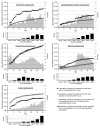Effect of Relocation to the U.S. on Asthma Risk Among Hispanics
- PMID: 28162842
- PMCID: PMC5401659
- DOI: 10.1016/j.amepre.2016.12.018
Effect of Relocation to the U.S. on Asthma Risk Among Hispanics
Abstract
Introduction: Asthma prevalence is reportedly higher among U.S.-born relative to foreign-born Hispanics/Latinos. Little is known about rates of asthma onset before and after relocation to the U.S. in Latinos. Asthma rates were examined by U.S. residence and country/territory of origin.
Methods: In 2015-2016, age at first onset of asthma symptoms was analyzed, defined retrospectively from a cross-sectional survey in 2008-2011, in relation to birthplace and U.S. residence among 15,573 U.S.-dwelling participants (aged 18-76 years) in the Hispanic Community Health Study/Study of Latinos.
Results: Cumulative incidence of asthma through age 30 years ranged from 7.9% among Mexican background individuals to 29.4% among those of Puerto Rican background. Among those born outside the U.S. mainland, the adjusted hazard for asthma was 1.52-fold higher (95% CI=1.25, 1.85) after relocation versus before relocation to the U.S. mainland, with heterogeneity in this association by Hispanic/Latino background (p-interaction<0.0001). Among foreign-born Dominicans and Mexicans, rates of asthma were greater after relocation versus before relocation (adjusted hazard ratio [AHR] for after versus before relocation, 2.42, 95% CI=1.44, 4.05 among Dominicans; AHR=2.90, 95% CI=2.02, 4.16 among Mexicans). Puerto Ricans had modestly increased asthma onset associated with U.S. mainland residence (AHR=1.52, 95% CI=1.06, 2.17). No similar increase associated with U.S. residence was observed among Central/South American immigrants (AHR=0.94, 95% CI=0.53, 1.67). Asthma rates among Cuban immigrants were lower after relocation (AHR=0.45, 95% CI=0.24, 0.82).
Conclusions: The effect of relocation to the U.S. on asthma risk among Hispanics is not uniform across Hispanic/Latino groups.
Copyright © 2017 American Journal of Preventive Medicine. Published by Elsevier Inc. All rights reserved.
Figures


Similar articles
-
Pulmonary Disease and Age at Immigration among Hispanics. Results from the Hispanic Community Health Study/Study of Latinos.Am J Respir Crit Care Med. 2016 Feb 15;193(4):386-95. doi: 10.1164/rccm.201506-1211OC. Am J Respir Crit Care Med. 2016. PMID: 26451874 Free PMC article.
-
Hypertension and diabetes prevalence among U.S. Hispanics by country of origin: the National Health Interview Survey 2000-2005.J Gen Intern Med. 2010 Aug;25(8):847-52. doi: 10.1007/s11606-010-1335-8. Epub 2010 May 19. J Gen Intern Med. 2010. PMID: 20490949 Free PMC article.
-
Influence of Birthplace and Age at Migration on Cognitive Aging Among Hispanic/Latino Populations in the United States: Study of Latinos-Investigation of Neurocognitive Aging.Gerontologist. 2025 Mar 25;65(4):gnaf009. doi: 10.1093/geront/gnaf009. Gerontologist. 2025. PMID: 39847471 Free PMC article.
-
Latino populations: a unique opportunity for epidemiological research of asthma.Paediatr Perinat Epidemiol. 2007 Nov;21 Suppl 3:15-22. doi: 10.1111/j.1365-3016.2007.00880.x. Paediatr Perinat Epidemiol. 2007. PMID: 17935571 Review.
-
Immigration and acculturation-related factors and asthma morbidity in Latino children.J Pediatr Psychol. 2011 Nov-Dec;36(10):1130-43. doi: 10.1093/jpepsy/jsr041. Epub 2011 Jul 10. J Pediatr Psychol. 2011. PMID: 21745811 Free PMC article. Review.
Cited by
-
The Association between Migration and Prevalence of Allergic Diseases: A Systematic Review and Meta-Analysis.Int Arch Allergy Immunol. 2024;185(11):1099-1122. doi: 10.1159/000539382. Epub 2024 Jun 20. Int Arch Allergy Immunol. 2024. PMID: 38901406 Free PMC article.
-
Role of ethnicity/language in documented rates of pediatric asthma prescription refills.J Asthma. 2023 Feb;60(2):360-367. doi: 10.1080/02770903.2022.2051545. Epub 2022 Mar 20. J Asthma. 2023. PMID: 35259312 Free PMC article.
-
Asthma Ambulatory Care Quality in Foreign-Born Latino Children in the United States.Acad Pediatr. 2022 May-Jun;22(4):647-656. doi: 10.1016/j.acap.2021.10.003. Epub 2021 Oct 22. Acad Pediatr. 2022. PMID: 34688905 Free PMC article.
-
Asthma Risk Associated with Indoor Mold Contamination in Hispanic Communities in Eastern Coachella Valley, California.J Environ Public Health. 2018 Oct 15;2018:9350370. doi: 10.1155/2018/9350370. eCollection 2018. J Environ Public Health. 2018. PMID: 30410546 Free PMC article.
-
Acculturation is associated with asthma burden and pulmonary function in Latino youth: The GALA II study.J Allergy Clin Immunol. 2019 May;143(5):1914-1922. doi: 10.1016/j.jaci.2018.12.1015. Epub 2019 Jan 22. J Allergy Clin Immunol. 2019. PMID: 30682453 Free PMC article.
References
-
- Barnett SBL, Nurmagambetov TA. Costs of asthma in the United States: 2002–2007. J Allergy Clin Immunol. 2011;127(1):145–152. http://dx.doi.org/10.1016/j.jaci.2010.10.020. - DOI - PubMed
-
- Asthma in the U.S. CDC vital signs. 2011 www.cdc.gov/vitalsigns/asthma/
-
- Asher MI, Montefort S, Björkstén B, et al. Worldwide time trends in the prevalence of symptoms of asthma , allergic rhinoconjunctivitis, and eczema in childhood : ISAAC Phases One and Three repeat multicountry cross-sectional surveys. Lancet. 2006;368(9537):733–743. http://dx.doi.org/10.1016/S0140-6736(06)69283-0. - DOI - PubMed
-
- To T, Stanojevic S, Moores G, et al. Global asthma prevalence in adults : findings from the cross-sectional world health survey. BMC Public Health. 2012;12(1):204. http://dx.doi.org/10.1186/1471-2458-12-204. - DOI - PMC - PubMed
-
- Subbarao P, Mandhane PJ, Sears MR. Asthma: epidemiology, etiology and risk factors. CMAJ. 2009;181(9):E181–90. http://dx.doi.org/10.1503/cmaj.080612. - DOI - PMC - PubMed
MeSH terms
Grants and funding
LinkOut - more resources
Full Text Sources
Other Literature Sources
Medical

